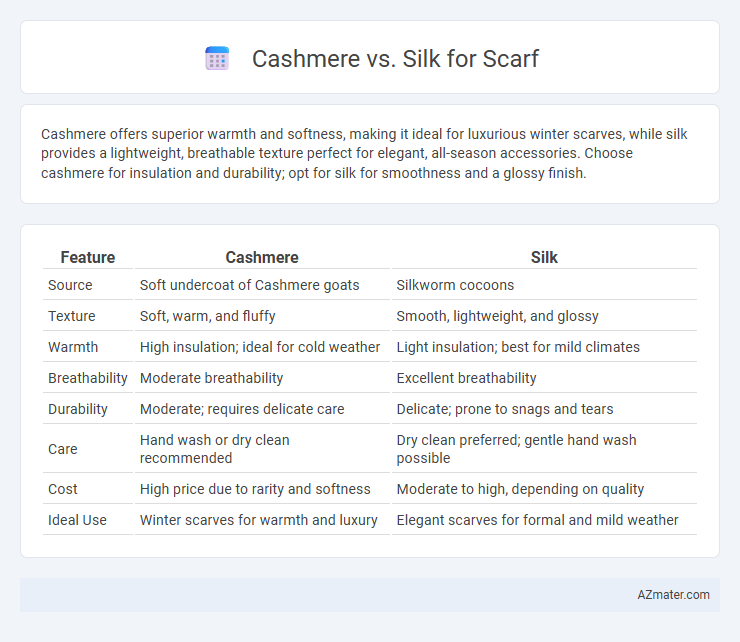Cashmere offers superior warmth and softness, making it ideal for luxurious winter scarves, while silk provides a lightweight, breathable texture perfect for elegant, all-season accessories. Choose cashmere for insulation and durability; opt for silk for smoothness and a glossy finish.
Table of Comparison
| Feature | Cashmere | Silk |
|---|---|---|
| Source | Soft undercoat of Cashmere goats | Silkworm cocoons |
| Texture | Soft, warm, and fluffy | Smooth, lightweight, and glossy |
| Warmth | High insulation; ideal for cold weather | Light insulation; best for mild climates |
| Breathability | Moderate breathability | Excellent breathability |
| Durability | Moderate; requires delicate care | Delicate; prone to snags and tears |
| Care | Hand wash or dry clean recommended | Dry clean preferred; gentle hand wash possible |
| Cost | High price due to rarity and softness | Moderate to high, depending on quality |
| Ideal Use | Winter scarves for warmth and luxury | Elegant scarves for formal and mild weather |
Introduction to Cashmere and Silk Scarves
Cashmere scarves, made from the soft undercoat of Cashmere goats, are prized for their exceptional warmth, lightweight texture, and luxurious softness, making them ideal for cold weather. Silk scarves, crafted from the natural protein fibers produced by silkworms, offer a smooth, glossy finish and breathable comfort, perfect for year-round wear and elegant styling. Both materials represent premium choices in scarves, balancing softness, durability, and style across various fashion needs.
Material Origins: Cashmere vs Silk
Cashmere is derived from the soft undercoat of cashmere goats predominantly found in regions like Mongolia, China, and Nepal, known for its exceptional warmth and softness. Silk originates from the cocoons of silkworms, primarily bred in China and India, prized for its smooth texture and natural sheen. Both materials offer luxurious qualities but differ significantly in their animal-based origins and production processes.
Texture and Feel: Comparing Softness
Cashmere scarves offer an exceptionally soft and luxurious texture, renowned for their lightweight warmth and smooth feel against the skin. Silk scarves provide a sleek, smooth, and glossy surface with a cool, delicate touch that drapes effortlessly. Comparing softness, cashmere delivers a plush, cozy sensation ideal for colder climates, while silk excels in breathability and a silky slip that feels gentle and elegant.
Warmth and Breathability Differences
Cashmere scarves provide superior warmth due to their densely packed, fine fibers that trap heat effectively, making them ideal for cold climates. Silk scarves offer exceptional breathability because of their natural protein structure, allowing moisture to evaporate and skin to breathe comfortably in milder temperatures. Choosing between cashmere and silk depends on the balance needed between insulation and ventilation for scarf wearers.
Durability and Longevity
Cashmere scarves offer exceptional warmth and softness but require delicate care to maintain durability, as their natural fibers can weaken with frequent washing. Silk scarves, renowned for their smooth texture and lightweight feel, provide greater resistance to wear and tear, making them more durable for everyday use. Both materials require proper maintenance to maximize longevity, with silk generally lasting longer under regular handling compared to cashmere.
Style and Versatility for Fashion
Cashmere scarves offer luxurious softness and warmth, making them ideal for sophisticated winter styles and layering with coats and sweaters. Silk scarves provide a lightweight, smooth texture that enhances elegance and versatility, easily transitioning from casual daytime looks to formal evening attire. Both materials elevate fashion statements, with cashmere excelling in cozy refinement and silk delivering vibrant prints and fluid draping options.
Seasonal Suitability: Which is Best?
Cashmere scarves excel in cold winter months due to their superior insulation and softness, effectively trapping heat for warmth. Silk scarves are ideal for spring and autumn, offering lightweight breathability and moisture-wicking properties that maintain comfort without overheating. Choosing between cashmere and silk depends on seasonal temperature and desired comfort level, with cashmere favored for cold climates and silk preferred for mild to moderately cool weather.
Care and Maintenance Tips
Cashmere scarves require gentle hand washing with cold water and mild detergent to maintain their softness and avoid fabric damage, while silk scarves demand similar care but with extra attention to avoiding harsh chemicals and prolonged sun exposure to preserve their delicate shine. Both fabrics benefit from air drying flat on a towel, never wrung or twisted, to maintain shape and avoid stretching. Proper storage in breathable cotton bags helps prevent moth damage to cashmere and yellowing of silk, ensuring longevity of the scarves.
Price and Value Comparison
Cashmere scarves typically command higher prices due to the rarity and softness of the wool, offering exceptional warmth and durability that justify the investment. Silk scarves, while generally more affordable, provide a lightweight, smooth texture and vibrant colors, making them versatile but less insulating. Choosing between cashmere and silk hinges on balancing budget constraints with preferences for luxury, warmth, and longevity in scarf use.
Choosing the Right Scarf: Cashmere or Silk?
Cashmere scarves offer unparalleled warmth and softness, making them ideal for colder climates and winter use, while silk scarves provide a lightweight, breathable option perfect for mild weather and elegant styling. Cashmere fibers trap heat efficiently and have a luxurious texture, whereas silk's natural sheen and smooth feel enhance versatility for both casual and formal wear. When choosing between cashmere and silk scarves, consider climate, occasion, and desired texture to select the scarf that best suits your functional needs and fashion preferences.

Infographic: Cashmere vs Silk for Scarf
 azmater.com
azmater.com